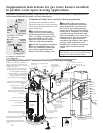
27
Care and cleaning of the water heater.
Draining the Water Heater
!
CAUTION: Shut off gas to the water
heater at the
gas control (thermostat) gas
cock or manual shut-off valve before
draining water.
!
DANGER: Before manually operating the
temperature and pressure relief valve, make
certain no one will be exposed to the hot
water released by the valve. The water
drained from the tank may be hot enough to
present a scald hazard and should be
directed to a suitable drain to prevent injury
or damage.
Before turning off the cold water supply to
the water heater, open a hot water faucet
allowing sufficient cold water into the
tank to prevent the risk of a scald injury
while draining the water heater. Once the
water in the tank is no longer hot, turn off
the cold water supply to the water heater.
Open a hot water faucet or lift the handle
on the relief valve to admit air to the tank.
Attach a garden hose to the drain
valve on the water heater and direct
the stream of water to a drain. Open
the valve.
Routine Preventative Maintenance
Properly maintained, your water heater
will provide years of dependable trouble-
free service.
It is recommended that a periodic
inspection of the gas control (thermostat),
burner, relief valve, internal flue-way and
venting system should be made by service
personnel qualified in gas appliance repair.
It is suggested that a routine preventative
maintenance program be established and
followed by the user.
Inspect plastic vent pipe. Make certain
that all joints are secure and that vent
pipe supports are all in place. Check
the outdoor vent terminal to see that it is
free of obstructions, and that there is no
damage nearby casused by condensate.
Inspect dilution air inlet and combustion
air inlet openings. Make certain no
blockage exists. Clean any lint, dirt or oil
accumulation that may exist.
At least once a year, lift and release the
lever handle on the temperature pressure
relief valve, located near the top of the
water heater, to make certain the valve
operates freely. Allow several gallons to
flush through the discharge line to an open
drain.
NOTICE: If the temperature and
pressure relief valve on the water heater
discharges periodically, this may be due
to thermal expansion in a closed water
system. Contact the water supplier or
your plumbing contractor on how to
correct this. DO NOT plug the relief
valve outlet.
A water heater’s tank can act as a settling
basin for solids suspended in the water.
It is therefore not uncommon for hard
water deposits to accumulate in the bottom
of the tank. If allowed to accumulate,
these solids can cover the gas control
(thermostat) sensors, causing the sensors to
operate erratically. Because accumulated
solids can prevent the gas control
(thermostat) sensors from accurately
reading the water temperature, the water
at the fixture can be hotter than the gas
control (thermostat) setting. It is suggested
that a few quarts of water be drained from
the water heater’s tank every month to
clean the tank of these deposits.
Rapid closing of faucets or solenoid valves
in automatic water using appliances can
cause a banging noise heard in a water
pipe. Strategically located risers in the
water pipe system or water hammer
arresting devices can be used to minimize
the problem.
The anode rod should be removed from the
water heater’s tank annually for inspection
and replaced when more than 6” of core
wire is exposed at either end of the rod.
Make sure the cold water supply is turned
off before removing anode rod.
This water heater incorporates a
combustion shut off device that shuts
the operation of the water heater down if
undesirable combustion conditions occur,
such as the presence of flammable vapors
or blockage of the combustion air inlet
openings. Please contact a Qualified
Service Technician if this occurs.
DANGER: Before
manually operating the
relief valve, make certain
no one will be exposed to
the danger of the hot water
released by the valve. The
water may be hot enough to
create a scald hazard. The
water should be released
into a suitable drain to
prevent injury or property
damage.
DANGER: Failure to
perform the recommended
Routine Preventative
Maintenance can harm the
proper operation of this
water heater, which can cause
carbon monoxide dangers,
excessive hot water
temperatures and other
potentially hazardous
conditions.
!
DANGER: Hotter water
increases the potential for
Hot Water Scalds.
Blower Assembly Dilution Air Holes
Location of Dilution Air Holes


















